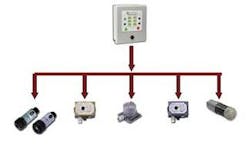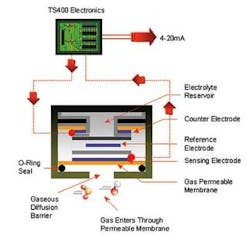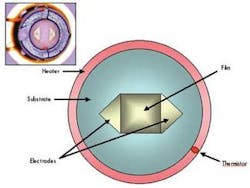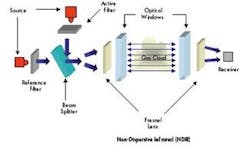Gas-Detection Sensors Protect Workers, Equipment
By Alan Austin
Chlorine (Cl2), methane, hydrogen sulfide (H2S), sulfur dioxide (SO2), nitric oxide (NO), and carbon monoxide (CO) can all pose dangers to employees and equipment in both clean water or wastewater treatment processes. Typical areas where toxic gas monitoring is necessary in water and wastewater treatment systems include:
• Cl2 Storage Room
• Sewage Collection (H2S, CH4, O2)
• Sludge Dewatering (H2s and CH4)
• Digester Tanks (H2S, CH4, O2)
• SO2 Storage Room
Gas Sensor Technologies
Employees face potential exposure to toxic gases, combustible gases and vapors, and oxygen deficiency throughout water and wastewater treatment facilities. The primary line of defense in protecting workers and equipment is the use of fixed-point gas detection sensors and monitoring systems.
Such systems typically consist of one or more electrochemical cell (EC), metal oxide semiconductor (MOS), catalytic-bead (CB), or infrared (IR) sensors placed at key locations throughout the facility. When toxic or combustible gas is present outside of acceptable limits, gas exposure data is communicated via hard wiring to the control station using analog or digital signals.
Electrochemical Sensing
Electrochemical sensors are widely used for both fixed gas detection systems and in hand-held portable devices for personal use where fixed gas detection systems are impractical. Such use is typically found in confined space areas where access is infrequent, or in large outdoor areas where the use of fixed gas detection systems is cost-prohibitive.
Electrochemical sensors consist of a sensing electrode, a counter electrode and a reference electrode separated by electrolyte. The gas to be detected diffuses through a capillary diffusion barrier, which controls the amount of gas reaching the sensing electrode. The target gas reacts at the surface of the sensing electrode by either oxidation or reduction. Reactions are catalyzed by specifically developed electrodes.
Gas detection with electrochemical cell sensing is reliable, accurate, responsive and relatively low in cost. The detectors require monthly recalibration of the cells, which typically last about 1-2 years, sometimes longer, depending on the gas sensor type and the operating environment.
Advantages:
• Detect a wide range of toxic gases.
• Are accurate, perform reliably.
• Are easy to use.
• Are small and lightweight for personal use.
• Are affordable.
Disadvantages:
• The detection range can be limited.
• They are not suitable for the harshest of environments.
• They require frequent recalibration.
MOS Sensing
In a metal oxide semiconductor (MOS) H2S gas detection sensor, the MOS film is deposited onto a substrate between two electrodes. With no gas present, the measured resistance between the two electrodes decreases (to kilo-ohms). This decrease in resistance is logarithmically proportional to the concentration of H2S gas that is present. The amplified signal is fed to an analog-to-digital (A-D) converter, which then digitizes the signal and sends it to a microprocessor for processing.
The process of H2S adsorbing onto the MOS film is most effective at an elevated temperature. To enhance gas detection, a heater ring is placed on the outer edge of the sensor's ceramic substrate. The heater ring temperature is measured with a thermistor and kept constant by a circuit located inside the body of the sensor, which is potted to negate variations in ambient temperature and humidity.
The MOS sensing operating principle is based on the fact that the semiconductor will preferentially adsorb H2S. When gas is present, the resistance across the MOS sensor's surface is reduced at a rate proportional to the concentration of gas present. A signal is then fed to a controller where it is linearized to drive a display, provide alarm outputs to warning devices such as horns and flashing lights. The process of H2S adsorbing onto the MOS film is also reversible. When the H2S gas dissipates, the resistance between the electrons increases. The sensor then indicates exposure levels have returned to a safe level.
Advantages:
• Solid-state (not wet cell) operation that is compatible with harsh environments.
• Highly selective to H2S, which provides a low risk of false alarms.
• Rugged, long-life sensor, which typically provides 3-5 years of service.
• Temperature is controlled well above ambient allowing for operation in low temperatures and high humidity.
• Robust mechanical design that is resistant to vibration and shock.
Disadvantages:
•There are relatively few disadvantages; the device requires some maintenance.
Catalytic Bead Sensing
For more than four decades, single-point catalytic (or electrocatalytic) detectors have been proven to be a highly responsive sensing technology. The catalytic bead sensor is based on the simple principle that a combustible gas produces heat as it oxidizes. The sensor converts this temperature change to a sensor signal, via a standard Wheatstone Bridge-type temperature transducer.
Typically, the sensor components include a pair of platinum heating coils embedded in a catalyst. As the reactants are all gaseous, the reaction takes place on the surface of the catalytic bead. The combustible gases react exothermically with oxygen in the air to raise the bead temperature. This creates a change of resistance within the embedded coil; the change in resistance is linearly proportional to gas concentration at the sensor.
Advantages:
• They are robust in the face of harsh ambient conditions.
• Operation is simple.
• They are relatively easy to install, calibrate and use.
• Service life is long with a relatively low lifecycle cost.
• They are highly reliable and predictable because they use proven technology.
• They are flexible for a wide range of applications.
• Calibration to individual gases is simple, such as hydrogen, which cannot be detected using devices based on infrared absorption.
Disadvantages:
• Catalysts can become poisoned or inactive due to contamination.
• Performing a routine gas check of the sensor is the only way to identify a loss of detector sensitivity, and then recalibrate the device as required.
• Sensors placed in locations known to contain potential poison, should be calibrated more frequently, and the results should be logged (the appropriate interval should be recommended by the manufacturer and verified in the field).
• Operation requires the presence of oxygen.
• Prolonged exposure to high concentrations of combustible gases may degrade sensor performance.
Infrared (IR) Sensing
Detecting dangerous gases with the infrared-detection method is based upon the absorption of IR radiation at specific wavelengths as the IR energy passes through a given volume of gas. A typical IR detector incorporates a light source and a light detector, which measures the intensity of two different wavelengths — one at the absorption wavelength of the gas being monitored, and one at a different wavelength.
When a gas mixture containing the monitored gas passes between the source and the detector, the level of IR radiation reaching the detector is reduced and can be continuously monitored. The gas concentration is then determined by comparing the relative values between the two wavelengths. There are two different types of IR detectors in use today: point-source and open-path.
The typical IR point-source detector is designed with a fixed path length between the IR source and the IR detector. This path length is typically short (only a few inches) and the gas concentration is assumed to be uniform across the path. With a fixed-path length, the measurement of IR-beam absorption by the gas being measured can be expressed directly (as % LEL, in this case).
A point-source IR detector is therefore capable of giving a true measurement of gas concentration at the point of detection. By comparison, open-path IR detectors expand the gas-sampling path from a few meters up to 100 meters. They are widely used to monitor large facilities and perimeter areas for gas clouds emanating from a leak or spill.
Advantages:
• They feature immunity to contamination and poisoning.
• Operation is fail-to-safe.
• There is no routine calibration.
• They operate in both the absence of oxygen, and in enriched-oxygen environments.
• They can operate reliably in the continuous presence of gas.
Disadvantages:
• The cost per point is higher typically at purchase. In the past, IR sensors have been more expensive than catalytic detectors, but they continue to come down in price (and now approach cost parity with catalytic detectors).
• Gases to be detected must be "infrared active," such as a hydrocarbon (users should consult the device manufacturer for guidance).
• Those gases that do not absorb IR energy (such as hydrogen) are not detectable (again, users should consult manufacturers for guidance).
• High humidity, and dusty or corrosive field environments can increase IR detector maintenance costs.
Conclusions
The hazards of toxic and combustible gas are unavoidably present in water and wastewater treatment plants. Their risks can be reduced and managed better, however, with the latest generation of intelligent gas sensing technologies and digital multi-channel controllers.
About the Author:
Alan Austin is Manager, Product Line Management, for General Monitors Inc. He has over 25 years of experience with controls and instrumentation. He holds a B.S. degree in Mechanical Engineering from East Berkshire College in London, England. Prior to working at General Monitors, he held the positions of Product Manager, National Sales Manager, Marketing Manager and General Sales Manager with Bestobell Controls and Instrumentation, Fluid Components and Weber Sensors.





